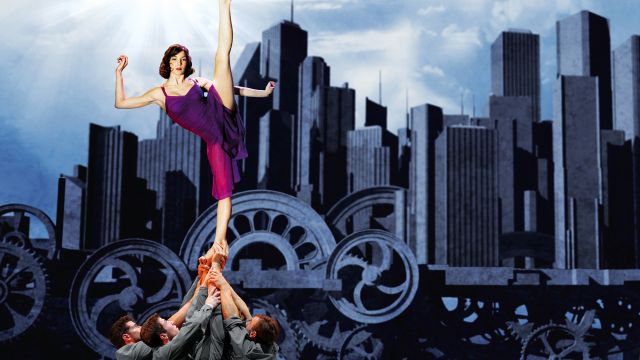Cirkopolis
Cirkopolisis ‘circus’, but not a circus with a ring, trained animals and red nose clowns. This show is big and its resources are more than sawdust and tinsel, skill and dedication. It scarcely ever lets up and can be all twelve performers juggling or one juggler juggling then dancing and juggling, and acrobatic routines on wheels and trapezes and poles and teeterboards, and some other routines that segue seamlessly into dances.
In one routine, a vertical pole is erected. Performers climb it, entwine with each, climb past each other and through each other. Then one performer drops straight down from the very top… and stops just before his skull connects with the floor. And then two performers do the same at once, then three…
It is amazing. Literally breathtaking. Throughout there are dangerous acrobatic feats of astonishing daring and skill. One routine after another where you say, ‘My God, did I just see that?’ The audience is entranced, gaping, constantly holding its breath… and then exhaling with relief… and then applauding. Are we meant to applaud? Is it bad form, like applauding between the movements of a symphony? No matter. 90 minutes of non-stop action is punctuated over and over with applause and no doubt it springs as much from relief as admiration. At the very end, a standing ovation that comes as much from gratitude as that same now awed admiration.
But the show has higher ambitions than mere ‘circus’. The program notes put it this way: ‘…in the heart of a stern and imposing city… twelve acrobats and multidisciplinary artists rebel against monotony, reinvent themselves and challenge the limits of the factory city.’ This is the ‘concept’ that holds the show together. Thus we begin with a hapless clerk (he’s the clown in this circus) endlessly shuffling endless paperwork until he disappears behind the pile. Robotic city workers in grey overcoats and snap-brim hats march relentlessly back and forth across the stage.
As the workers transform into performers, the clerk/clown is lured away, but he is never quite integrated into the human pyramids, trapeze routines and so on. All the same, one of the loveliest interludes occurs when the frenetic pace pauses and the clerk/clown tries to impress and seduce a red dress on a clothes hanger in a way worthy of Chaplin. (I could have done with more of this sort of thing – that is, explicit humour. Cf. Circus Oz.)
Behind all the movement and giving a vertiginous illusion of depth, there are huge, beautiful but ominous computer generated images of soulless industrial buildings, slowly grinding machine cogs and skyscraper city skylines (design by Robert Massicotte and Alexis Laurence). Nicolas Descôteaux’ lighting plays cleverly in sync with these images and lights just enough of the stage. An original music score by Stéfan Boucher both complements and comments on the routines: ominous, mechanically grating, lyrical, poppy-sweet, sad and back to ominous.
However, and perhaps I too have succumbed to the modern disability of a reduced attention span, but I couldn’t help feeling – albeit awed – that these amazing feats all go on too long. We are amazed at somethign and then we see it again, so yes, we did see that, but then we see it twice or three times more. An example: one routine involves a performer in a red dress spinning a large hoop onto the stage. She can do just about anything with this hoop and it becomes more incredible as it goes on. The hoop is spins around her on its rim, but within seconds it’s spinning on its rim with her inside it – vertically, diagonally, two hands, one hand. Not only is it amazing, it’s also wonderful in the way she imbues this progression with a kind of quiet grace – not at all showy. But having totally won us over, the act is repeated – and repeated. She and the hoop leave the stage, but they come back – and do* it again. Dare I say, in the face of this grace and skill and the devotion to perfection that makes both possible, that I became at times a little restless? Even a little impatient?
Secondly, although it was obvious that the packed house was having a whale of a time, my guess is that our pleasure came primarily from sheer admiration of physical skill, grace and courage – followed by the flashes of humour, the attractive nature of the performers and the contribution of images, lighting and music. The claims made for the show by Mr St-Pierre and Mr Painchaud may be a little extravagant. Were we really transported ‘between dream and reality’? Is the show really ‘driven by the poetic impulse of life’? Possibly not, but unless that is what you are specifically seeking, Cirkopolis truly is a brilliant entertainment and a parade of the most challenging, courageous and spectacular skills. The audience poured out a little dazed but smiling.
Michael Brindley
Subscribe to our E-Newsletter, buy our latest print edition or find a Performing Arts book at Book Nook.

